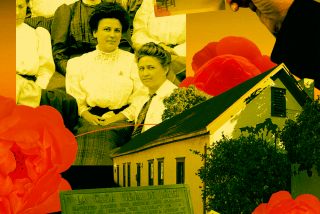Santa Barbara Rebuilds Its Colorful History
- Share via
SANTA BARBARA — A formal ceremony Thursday marked the completion of restoration work on the chapel that once was a part of Santa Barbara’s original Spanish presidio, and was first dedicated Dec. 12, 1797.
It was another step in a long-range program to rebuild the entire presidio as it was after the founding of Santa Barbara on April 12, 1782. At that time, the Spanish governor, Felipe de Neve, accompanied by Father Junipero Serra and a company of soldiers, established the colony. Lt. Jose Francisco Ortega was the presidio’s first commandant. A fort was constructed containing quarters for the soldiers and commandant and a chapel.
Four years after the presidio’s founding, work was begun on the majestic Santa Barbara Mission, a mile north.
With the success of the Mexican revolt against Spain in 1822, a new tri-colored flag was raised over the presidio. It remained a Mexican fort until 1848 when the United States signed a treaty ending the war with Mexico. During the conflict, American troops and naval forces had occupied California. Statehood followed in 1850. During the ensuing years, the presidio fell into ruins. Buildings were cannibalized to build other structures. The commandant’s quarters survived until 1925, when it was leveled by an earthquake.
The construction of the original chapel was done by the presidio’s garrison aided by native Indians using adobe with a stone foundation. The reconstruction work has been done chiefly by members of the California Conservation Corps who have been laboring on the project for several years. Bringing soil from the Santa Barbara mission, they fashioned thousands of bricks from clay and sand. Straw and pine needles were mixed with the soil. Liquid asphalt, an ingredient not available to the Spanish builders, was added to stabilize the bricks.
The presidio project, which is located in the city’s downtown at Canon Perdido and Santa Barbara streets, was inaugurated in 1963 by the Santa Barbara Trust for Historical Preservation, a nonprofit organization that receives its financial support from residents of the community and corporations and business establishments. The trust has acquired eight acres of the original property. Parcels of the land have either been donated or sold to the state below market value. The trust now operates the site under an agreement with the state Department of Parks and Recreation. While state, county and city revenues have been provided for land acquisition in the presidio locale, the financing of reconstruction has been largely accomplished by the trust. Jarrell C. Jackman serves as administrator of the trust and is in charge of the project.
“When we began work on the presidio, we were fortunate to have the original Spanish plans,” he said. “The document signed by the commandant is in the Bancroft Library at UC Berkeley.”
Norman Neuerburg, a Los Angeles artist and expert on Spanish colonial art and architecture, worked on the building plans and has painted designs on the interior walls similar to ones that would have been done in the late 18th Century. Neuerburg retired three years ago from Cal State Dominguez Hills where he taught art history. He is currently painting the interior of a new church at San Juan Capistrano.
“It will probably take 20 years to complete the restoration of the presidio with the various buildings that were here,” Jackman said. “We have to acquire additional property, and there are archeological studies and other research to be done.
“When it is completed, the public will have a better understanding of the state’s history. People now associate the Spanish period with the chain of Franciscan missions, but the presidios were also of importance. Not only were they the military headquarters for the entire region--and this one’s governing authority extended from present-day San Luis Obispo County to and including the pueblo of Los Angeles--they were the principal means of colonization for extending frontiers of the Spanish Empire. Towns that would later become cities were built around them. The earliest settlers came from Mexico.”
An open house will be held in the chapel Saturday from noon to 4 p.m. and on Sunday from 11 a.m. to 3 p.m.
More to Read
Sign up for Essential California
The most important California stories and recommendations in your inbox every morning.
You may occasionally receive promotional content from the Los Angeles Times.













